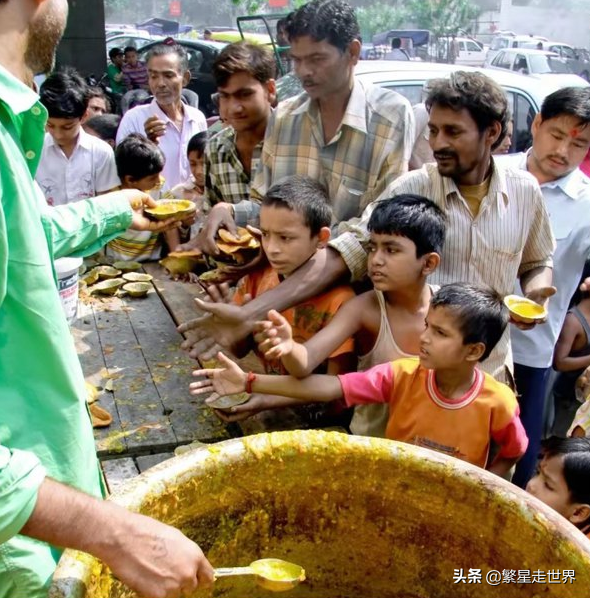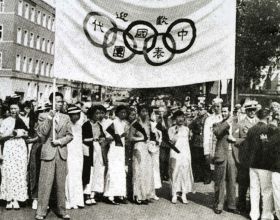關於龍象之間的比較,一致都是津津樂道的話題之一,印度網友對此也樂此不疲,雖然一部分印度網友透過旅遊學習等渠道從根本上認識了龍象之間的差距,但在印度國內,還是有不少人存在這盲目的自信,在美版知乎上,就有網友提出了這個問題,為什麼中國發展得比印度快這麼多?網友米婭·布朗做出了回答
There are many similarities between India and China. They are among the four ancient civilizations of the world, with a long history and splendid ancient civilizations. They are both very populous countries in Asia. So it is not surprising that the two countries are compared side by side. Although India's GDP growth has been good in recent years and its population will soon surpass China's, in many ways India is not developing as well as China.
印度和中國之間有許多相似之處。他們是世界四大文明古國之一,有著悠久的歷史和燦爛的文明古國。他們都是亞洲人口眾多的國家。因此,將這兩個國家並肩比較並不奇怪。儘管印度近年來GDP增長良好,其人口很快將超過中國,但在許多方面,印度的發展不如中國。
In 2019, India's GDP was $2.85 trillion, ranking fifth in the world, while China's GDP reached $14.36 trillion, ranking second in the world. China's GDP was about 5.04 times that of India during the same period. China's per capita income is already four times India's. (In DOLLARS)
India has 25 percent more arable land than China, second only to the United States, but in nearly 70 years from 1949 to 2016, India's per capita grain production was only about 200 kg, not even the level of China in 1949.
2019年,印度GDP為2.85萬億美元,居世界第五位,而中國GDP達到14.36萬億美元,居世界第二位。同期,中國GDP約為印度的5.04倍。中國的人均收入已經是印度的四倍(美元)
印度的可耕地面積比中國多25%,僅次於美國,但從1949年到2016年的近70年間,印度的人均糧食產量僅為200公斤左右,甚至不及1949年的中國水平。
The share of output value of Indian industry rose slowly from 13.6% in 1950 to 24.7% in 2006, basically stagnating for nearly 30 years. China's industrial output rose from 20% in 1952 to nearly 50% in 2006.
In terms of highway length, China had 41,000 km in 2005 (130,000 km in 2016) while India had only 1,300 km in 2016.
印度工業產值佔比從1950年的13.6%緩慢上升到2006年的24.7%,基本停滯了近30年。中國的工業產出從1952年的20%上升到2006年的近50%。
就公路長度而言,中國在2005年有41000公里(2016年為130000公里),而印度在2016年只有1300公里。
In terms of import and export trade volume, China is $4.4 trillion and India is $760 billion.
China's poor account for only about 5% of the total population, while India accounts for half.
(all the above are from reliable public data.)
So Why has China developed so much faster than India?
就進出口貿易額而言,中國為4.4萬億美元,印度為7600億美元。
中國的窮人只佔總人口的5%左右,而印度佔一半。
(以上所有資料均來自可靠的公共資料。)
那麼,為什麼中國的發展速度比印度快得多呢?
1.China's strategy of Rejuvenating the country through science and education. Talented people are very important to the development of a country. It won't take long for India's population to catch up with China's, but there is still a gap between the quality of its labor force and China's. Most of the population does not have modern knowledge system, especially the most basic knowledge of natural science. In China, however, thanks to simplified Chinese characters and the popularization of nine-year compulsory education, the illiteracy rate dropped from 80 percent to 2.67 percent between 1949 and 2021. According to UNESCO, India has the world's largest illiterate population, with 287 million adults illiterate. By contrast, China has a large and well-qualified labor force and talent capital. There are nearly 900 million working people, 170 million with higher education or professional skills, and more than 91 million scientific and technological workers, providing a human resource guarantee for the development of China's science and technology, industry and information industries.
一、中國科教興國戰略。人才對一個國家的發展非常重要。印度人口很快就會趕上中國,但其勞動力質量與中國仍有差距。大多數人口不具備現代知識體系,特別是最基本的自然科學知識。然而,在中國,由於簡化漢字和普及九年義務教育,文盲率在1949至2021年間從80%下降到了2.67%。根據聯合國教科文組織的資料,印度是世界上文盲人口最多的國家,有2.87億成年人是文盲。相比之下,中國擁有大量合格的勞動力和人才資本。有近9億勞動人口,1.7億受過高等教育或具有專業技能,9100多萬科技工作者,為中國科技、工業和資訊產業的發展提供了人力資源保障。
1.China's institutional advantages. One might argue with me, because western scholars generally believe that Indian democracy is better. India is a multi-party state, with some Western traditions from the British colonial period preserved and election decisions made in the west. The United States is a country with many parties. Let's see what the parties are.
中國的制度優勢。有人可能會和我爭論,因為西方學者普遍認為印度民主更好。印度是一個多黨制國家,保留了英國殖民時期的一些西方傳統,選舉決定在西方作出。美國是一個政黨眾多的國家。讓我們看看派對是什麼。
There used to be an old saying to describe Indian politics, "Decree does not leave New Delhi", which shows the inefficiency of Indian administration. Not only that, India also has high levels of corruption. The control, appeal, and organizational level of the Indian government and political parties are far below people's expectations.
Moreover, the caste system has always existed in India and the fortress between classes can never be broken, so how to guarantee social equity, educational equity and social vitality? Moreover, the caste system has always existed in India and the fortress between classes can never be broken, so how to guarantee social equity, educational equity and social vitality? Upper castes do not have to work very hard to get good jobs and enjoy good treatment, which encourages some of them to be lazy; The lower castes, on the other hand, have to suffer, thinking that this is their destiny and cannot be changed. The result is that their creative spirit and initiative are restricted and restrained.
曾經有句古話來形容印度政治,“法令不出新德里”,可見印度政府的低效率。不僅如此,印度的腐敗也很嚴重。印度政府和政黨的控制力、號召力和組織水平都遠低於人們的預期。
而且,種姓制度在印度一直存在,階級之間的堡壘永遠無法打破,那麼如何保證社會公平、教育公平和社會活力?而且,種姓制度在印度一直存在,階級之間的堡壘永遠無法打破,那麼如何保證社會公平、教育公平和社會活力?上層種姓不一定要努力工作才能找到好工作和享受好待遇,這會鼓勵他們中的一些人變得懶惰;另一方面,低種姓不得不受苦,認為這是他們的命運,無法改變。其結果是他們的創作精神和主動性受到限制和約束。
The advantages of China's socialist system are reflected in the fact that China is led by the communist Party of China and has a unified ideology, high organizational discipline and high work efficiency. At the same time, the socialist system has the political advantage of being able to concentrate resources to accomplish major tasks and organize forces from all sectors of society to form a strong synergy. Moreover, the Chinese people are the real masters of China, so we can find that China has done a good job in ensuring the unity of urban and rural areas, the employment system of fair competition, and improving the rural social security system.
中國社會主義制度的優勢體現在中國共產黨領導下,思想統一,組織紀律嚴明,工作效率高。同時,社會主義制度具有能夠集中資源完成重大任務、組織社會各界力量形成強大合力的政治優勢。而且,中國人民才是中國真正的主人翁,可見中國在保障城鄉統一、公平競爭的就業制度、完善農村社會保障體系等方面做得很好。
I'm talking about what I think are the deeper reasons, and there are many other reasons as well, which are described in detail in other answers. In short, for India to truly rise, it may indeed need a subversive social revolution to change its loose system, backward caste system, unprogressive national character, and grossly unequal education. Otherwise, the gap between China and India will continue to widen.
我說的是我認為更深層次的原因,還有很多其他原因,在其他答案中有詳細描述。總之,印度要真正崛起,可能確實需要一場顛覆性的社會革命來改變其鬆散的制度、落後的種姓制度、不進步的民族性格和極度不平等的教育。否則,中印之間的差距將繼續拉大。
非營利組織 TechnoGeek 總裁奧哈斯·阿羅拉進一步說明到
兩國在1950年時GDP基本相同,但後面為什麼不同了呢?
All that was different was China’s realization in 1980’s and post 1980 polices. Let’s have a look at the differences and analyse ideologically.
不同的是中國在 1980 年代和1980 年後的政策. 讓我們來看看差異並從思想上進行分析
- When India was busy discussing Religions, China was working on it’s economic policies:
India was and still is busy fighting internally, discussing which religion to follow, what to eat, and what all does the different religions allow, China was making policies and bringing in economic revolution.
- 當印度忙於討論宗教時,中國正在制定其經濟政策:
印度過去和現在都在忙於內部鬥爭,討論信奉哪種宗教,吃什麼,以及不同宗教都允許什麼,中國正在制定政策並帶來經濟改革.
- When India was busy producing Children, Chinese brought the One Child Policy:
India’s population as we all know had been increasing at an alarming rate, so was the Chinese population but here came the Chinese policy of One Child and it certainly made all the difference. China went up with the maximum working population(age group of 20–24 as the International Labor Organisation calculates) with less number of Infants and Old people.
- 當印度忙於生孩子時,中國人帶來了獨生子女政策:
眾所周知,印度人口以驚人的速度增長,中國人口也是如此,但中國的獨生子女政策來了,這無疑使一切變得不同。中國以最高工作人口(國際勞工組織計算的 20-24 歲年齡組)上升,嬰兒和老年人數量較少。
- When India’s was struggling to give basic education to the people, Chinese gave advance education to the population:
India almost has 224 million people poised to get into higher education and of the age group of (10–19 years) but only 18% actually reached into the college or University or some other Higher education system(sad but true).
- 當印度努力為人民提供基礎教育時,中國為人民提供了先進的教育:
印度幾乎有 2.24 億人準備接受高等教育和年齡組(10-19 歲),但只有 18% 的人真正進入了學院或大學或其他一些高等教育系統(悲傷但真實)。
- When India was busy giving jobs and seats to the reserved, China gave jobs to and seats to the deserved.
India’s reservation policy is an absolute disadvantage. The people are given Jobs on the basis of their caste and not on their family’s income or efficiency. That’s the modern form of discrimination in India.
- 當印度忙於為保留的人提供工作和席位時,中國給了應得的工作和席位。
印度的保留政策是絕對的劣勢。人們根據他們的種姓而不是他們的家庭收入或效率獲得工作。這就是印度的現代歧視形式。
- When India was busy learning English, Chinese spent the same time thinking, and implementing in “Chinese Language”:
Indians are taught English first and Science later. Chinese however use their mother tongue and excel in every field.
- 在印度忙於學習英語的同時,中國人也在用“漢語”來思考和實踐:
印度人先學英語,後學科學。然而,中國人使用他們的母語,並且在各個領域都表現出色。
- When Indians were busy struggling with Licence Raj, Chinese gave way to open trade and focused on Exports.
License Raj was one of the most distressing things that India got rid off at the time of 1991.
- 當印度人忙於與License Raj鬥爭時,中國讓位於開放貿易並專注於出口。
License Raj 是印度在 1991 年擺脫的最令人痛苦的事情之一。
- When India was struggling with Emergency and other instabilities of Governments, Chinese had the Communist party taking up decisions bluntly and paving way for development.
Although many challenge that Single Party System of China is not good, it is efficient enough to stop the hurdles coming in the path of development.
- 當印度正與政府的緊急狀態和其他不穩定因素作鬥爭時,中國直言不諱地做出決定併為發展鋪平道路。
儘管許多人說中國的不好,但她的效率足以清除發展道路上的障礙。
- While India was busy working for Americans and doing the Tertiary works, China was committed to become a Manufacturing Hub in the world.
Yes, India’s Jobs depend on the outsourcing. Trump comes in and we loose jobs, however in China the manufacturing and exports make it a stable economy.
- 當印度忙於為美國人工作並從事第三產業時,中國則致力於成為世界製造中心。
是的,印度的工作依賴於外包。特朗普上臺,我們失業了,但在中國,製造業和出口使其經濟穩定。

























